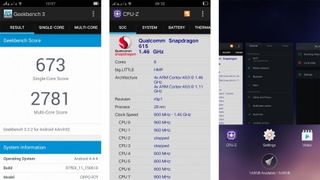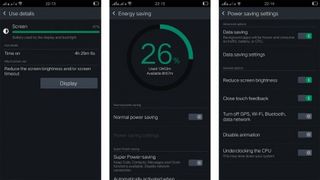Why you can trust TechRadar
Performance
At the heart of the Oppo R7 you'll find a 64-bit 1.5Ghz Qualcomm Snapdragon 615 octa-core processor, an Adreno 405 GPU and 3GB RAM –1GB more than its predecessor.
The R7 may struggle to compete against the latest crop of high-end offerings, but it certainly punches well above its weight. For an affordable smartphone these specs are mightily impressive, and should enable the R7 to keep pace with powerful mid-range rivals such as the Oneplus One.
Sure enough, consistently high Geekbench 3 multi-core test results show that the R7 is right up there with some of the most capable handsets in its price category.
An average score of 2,755 puts the R7 considerably ahead of most similarly-priced devices like the Alcatel OneTouch Idol 3 (2,066), with it only just losing out to the mighty OnePlus One (3,050) and Honor 6 (3,148). Oppo's latest offering also outperforms the R5 (2,644) and produces a comparable score to 2014 flagships such as the HTC One M8 (2,899).

In real-world use, navigating through Color OS 2.1 on the R7 is a breeze. There's no sign of any stutter or lag anywhere in the UI and the 3GB RAM ensures multitasking is managed competently.
With the latest software update, Oppo has included a multitude of optimisations and it really shows. Apps load up almost instantaneously, and with a low crash rate of 0.3% they stay open for as long as you need them to.
If you enjoy casual gaming on the go the R7 won't disappoint, and popular titles such as Temple Run 2 and Crossy Road run incredibly smoothly. More graphically-intensive games, such as Real Racing 3, are handled adequately, although the R7's thin metal unibody does have a tendency to heat up rather rapidly.
Battery life
Crammed into the 6.3mm-thick Oppo R7 is a non-removable 2320mAh battery. Despite not being particularly large for a 5-inch device, it's a welcome upgrade from the paltry 2000mAh cell found in the thinner R5.
Software enhancements and the inclusion of the power-efficient Snapdragon 615 processor and AMOLED display help to conserve juice, resulting in acceptable, if not remarkable, battery life.
Light-to-moderate users will make it through the day without too much difficulty, and four to five hours of screen-on time is achievable on a single charge. That being said, media fanatics and heavy users of the R7's dual-SIM feature may have to reach for the VOOC charger before the day is out.

Thanks to its power-efficient internals the R7 performed fairly well in the techradar HD video test. After playing the 90-minute clip, with brightness and volume levels set to maximum, the R7's battery only depleted by 25% – that's 2% better than the Acer Liquid Jade S and Oppo R5, and 1% better than the Google Nexus 5.
Unfortunately the R7 doesn't fair so well against the some of its biggest mid-range rivals. The OnePlus One still had 83% juice left after completing the test, and the ZTE Blade S6 only lost 16% over the course of the clip.
Unlike those last two competitors, however, the Oppo R7 is currently using Android 4.4.4 KitKat as a base, rather than Lollipop. Unlike Google's latest OS, KitKat is not fully optimised to support 64-bit processors like the Snapdragon 615, and so there's potential for battery life to improve after the R7 receives an update to Android 5.1.
If the R7's battery is in the red and you can't get to a power outlet, you'll have to resort to using the included 'Normal' and 'Super' power-saving modes. The ability to customise the 'Normal' mode is a nice touch, enabling you to freeze background apps, disable animations and underclock the CPU.
The 'Super' mode works in much the same way as the 'Ultra power saving' mode on Samsung devices. The majority of smartphone functions are limited, leaving you with access only to the dialer, contacts, messages and clock – so unless you're really desperate to conserve power, you'll probably want to avoid using this feature.
The essentials
The Oppo R7 is a wonderfully designed device packed full of innovative features, but that doesn't mean the Chinese firm has neglected the essentials.
Although the majority of smartphones nowadays are perfectly capable of providing a decent calling experience, the R7 is one of the more competent devices I've used.
Sound during calls is rich through the earpiece, and the combination of a quality pair of microphones ensures that your voice comes through clearly, even in the loudest of environments.
Rear-firing speakers aren't usually up to much, but the unit on the R7 is an exception. I was pleasantly surprised by how crisp calls sounded over the speakerphone, and thanks to an almost deafening maximum volume level you won't need to rely on the vibrate function to know when you've got a call or notification.

There's nothing flashy about the key apps on the R7, yet Color OS 2.1 provides the core smartphone features in a simple and straightforward manner.
'Easy dial' is available in the phone app, giving you a quick way of sifting through your contacts list and placing a call. Narrowing down your search to a specific individual also gives you the option to fire off a text message or view detailed contact information.
Oppo's contact management system is comparable to that found on Samsung devices, which is a definite plus. Contact details can be hauled in from numerous sources, including Google, email accounts and installed social networking apps, enabling you to store them in one convenient place.
Two SMS options are baked into the R7's software, the default Messages app and Google Hangouts.
I'm not usually a fan of stock messaging apps, but I was pleasantly surprised by Oppo's offering. It elegantly incorporates dual-SIM functionality, and the pop-up feature is really handy for replying to texts without having to dive into the app itself.
If you're deeply integrated with Google services and want a more of an ecosystem-centred experience, then you may want to switch to Hangouts. However, for the average user the stock messaging app will be more than adequate.

Regardless of the messaging app, you'll enjoy typing on the included Swype keyboard. As you'd expect from such a popular board the keys are nicely spaced, gesture typing is fluid and autocorrect is pretty reliable.
Numerous languages can be downloaded in the keyboard settings and, once configured, are easily accessible via the spacebar. Unfortunately not all of them are supported by Swype's neat bilingual typing feature, which simultaneously shows word predictions for two different languages.
With a beautiful 5-inch 1080P AMOLED display, slim design and 4G LTE connectivity, the R7 is tailor-made for light web browsing on the go. Websites are quick to load, whether you're using Google Chrome or the stock browser, and scrolling is buttery smooth.
If it wasn't for history and bookmark syncing in Chrome I'd solely use the stock browser, as Oppo's internet app includes reader-friendly full-screen and night modes.
Media fanatics who prefer watching videos or listening to music won't be disappointed either. The R7's display is an all-round strong performer and, as you'd expect from a company that makes audio equipment, sound quality is superb through both the rear-facing speaker and 3.5mm headphone jack.

